Category Archives: Holy Places
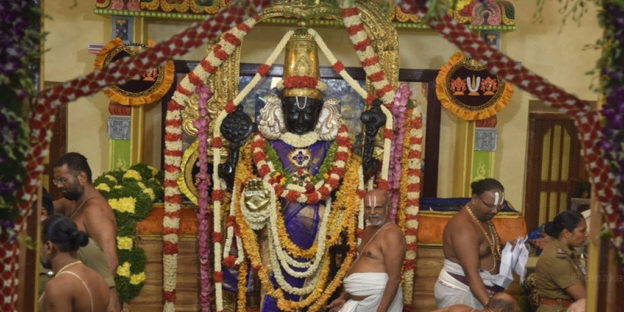
Kanchipuram

Kanchipuram is considered to be the Banaras (Varanasi / Kashi) of South India. Of the 108 divya desams, fourteen are inside Kanchipuram area. The Garuda purana enumerates seven most sacred places which bestow liberation (Moksha Puri) are Ayodhya, Mathura, Maya (Mayapuri or Haridwar), Kashi (Varanasi), Kanchi (Kanchipuram), Avantika (Ujjain) and Dwaravati (Dwaraka). These seven cities are giver of Moksha (Liberation) and are called Mokshapuri.
अयोध्या मथुरा माया काशी काञ्ची अवन्तिका ।
पुरी द्वारावती चैव सप्तैते मोक्षदायकाः ॥
Lord Sri Chaitanya Mahaprabhu visited Kanchipuram during his tour of South India and he spent two days in Kanchipuram. It is 75km from Chennai, 130km from Tirupati and 32km from Sriperumbudur (birthplace of Sripad Ramanujacarya).
Kanchipuram city is divided into two parts: the Little Kanchi (or Vishnu Kanchi) surrounding by Sri Varadaraja Perumal Temple, and the Big Kanchi (or Siva Kanchi) surrounding Sri Ekambaranathar Temple. Kanchipuram is also prominently known for silk industry. Sri Chaitanya-Charitamrita Madhya lila 9.68-70 mentions: Arriving at Siva-kanchi, Chaitanya Mahaprabhu visited the deity of Lord Siva. By His influence, He converted all the devotees of Lord Siva into Vaishnavas. The Lord then visited a holy place known as Vishnu-kanchi. There He saw Laksmi-Narayana deities, and He offered His respects and many prayers to please Them. Vishnu-kanchi is situated about five miles away from Kanchipuram. Lord Varadaraja, another form of Lord Vishnu, resides here. There is also a big lake known as Ananta-sarovara. When Sri Chaitanya Mahaprabhu stayed at Vishnu-kanchi for two days, He danced and performed kirtana in ecstasy. When all the people saw Him, they became devotees of Lord Krishna.
Original Story:
One very prominent story that runs practically across all the temples of Kanchipuram. Practically all the temples in Kanchipuram have sprung from one single story. One will find the reason of the existence of these temples, its greatness and beauty of this holy city.
This story is from the beginning of Satya yuga.
Lord Brahma performed extreme penances to have a deity of Lord Narayana and wanted to worship with love and devotion. Pleased by Lord Brahma’s penances, Lord Narayana benedicted him that Lord will appear in the form of a holy place known as Naimisharanya. Brahmaji was happy that a holy place was manifested but he was still not satisfied because he wanted to see the personal form of the Lord. He continued his prayers and as he continued his prayers, the Lord next appeared in the form of water body (Sarovar/ Lake) named Pushkar. But Brahma felt that he wanted to actually experience the Lord in his personal form and continued praying.
This time Lord actually appeared and told him to perform thousand Ashwamedha yajnas to see the direct form of the Lord. Lord Brahma pleaded that thousand yajnas will take a lot of time. Please tell me a method which is much quicker to experience your personal form of the Lord. The Lord told him there is one way out. He said, “If you go to Holy Place of Kanchipuram and perform one Yajna, it is equivalent to performing thousand yajnas.
So, Lord Brahma decided that he will go to Kanchipuram and perform this yajna. Even today whatever spiritual practices is performed in Kanchipuram, one get thousand fold results.
So, Brahma wanted to go to Kanchipuram and perform this yajna and he invited his wife Saraswati to be a part of this historic Yajna. Somehow, he was not able to find Saraswati and invite her. Due to lack of time, Brahma began the Yajna. And as soon as the yajna began, many impediments came.
Interestingly, the first obstacle was created by his own wife, Saraswati. So, when Saraswati came to know that Brahma was performing Yajna without her, she was really upset. She wanted to destroy the Yajna by sending the first obstacle in the form of a massive river which was coming at full speed like a tsunami. It was about to blow the yajna. Lord Brahma desperately sought shelter of Lord Narayana. Lord Narayana appeared as Vega Sethu, a deity sleeping on Ananta-Sesa. He was like a dam that stopped the flow of the river, Veghavati river. Vega means speed and Sethu means dam. A dam which obstructs the speed of a river. The Lord lies down in front of raging river and thus the Yajna place was saved.
The next obstacle came in the form of demons.
The demons wanted to obstruct the Yajna of Lord Brahma. So, they created complete darkness and Brahma could see nothing around.
Now imagine you’re doing it, you’re trying to do something focused and its absolutely pitch dark.
How can someone perform yajna in complete darkness? Lord Brahma took shelter of the Lord, and the Lord appeared in another form, Deepak Prakash, and created wonderful light. In this particular form, Lord Vishnu appeared as light. The Brahman effulgence that comes out from the body of Vishnu. It actually came in assistance of Lord Brahma to help see things.
Then Brahma continued performing his Yajna.This time the demons sent a very ferocious beast named as Sharaba. Sharaba is a very interesting type of animal which is a combination of five animals. It has a bird form, an elephant, a lion, a human and a snake.
The demon sent the Sharaba to attack Lord Brahma’s Yajna. Lord Brahma took shelter of Lord Narayana. Lord Narayana appeared in a very amazing form which is known as Ashtabujha (eight-armed form) and defeated the Sharaba animal and protected the yajna of Lord Brahma.
As Brahma continued performing his yajna, this time the demons came down to harrass Lord Brahma. They actually started troubling Brahma physically, trying to torture him and trying to kill him. At that time the Lord Brahma again prayed to the Supreme Lord, and this time, Narayana appeared as Lord Narasimha there. The Lord jumped at the demons and they all got scared and ran away.
When the Lord saw that all the demons ran away, He sat down in front of the Yajna kunda in a yogic posture, and therefore he became celebrated as the yoga Narasimha. Brahma continued performing yajna with pure devotion intensely for the appearance of the Supreme Lord. Then from within the Yajna kunda, appeared a beautiful (Vimaan) airplane. Especially when he appears through the fire yajnas, he appears in his Viman Airplane.
Once the yajna was completed, this beautiful vimana arose from the yajna kunda and a beautiful four handed deity of Lord Vishnu in a very magnanimous and merciful form was present. The Deity was folding his hands in a posture to give blessings (Varada), and this particular form of the Lord is known as Varadaraj, the king of giver of blessings. It is this Varadaraja Swamy who is the predominating deity of Vishnu Kanchi.
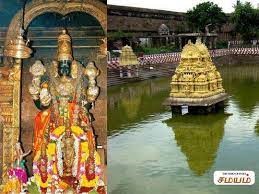
Temples in and around Kanchipuram and the respective deities.
Important temples in Kanchipuram:
1. Sri Deepa Prakasar Perumal Temple (or Thiruthanka)
2. Sri Ashtabujam Perumal Temple (or Sri Aadhikesava)
3. Sri Azhagiya Singar Perumal Temple (or Thiru Velukkai)
4. Sri Varadaraja Perumal Temple (or Thiru Kanchi)
5. Sri Yatoktakari Temple (or Thiru Vekka)
6. Sri Ulagalantha Perumal Temple (or Thiru Ooragam) and Sri Thirukkaar Vaanar Temple (or Thirukkaar Vaanam)
7. Sri Vaikunda Perumal Temple (or Thiruparameshwara Vinnagaram)
8. Sri Pandava Dhootha Temple (or Thiru Paadagam)
9. Sri Pachai Vannar Temple and Sri Pavalai Vannar Temple (or Thiru Pavala Vannan)
10. Sri Ekambaranathar Temple and Sri Nilathingal Thundathan Perumal Temple
11. Sri Kamakshi Temple and Sri Aadhi Varaha Perumal Temple
12. Sri Vijayaraghava Perumal Temple (or Thiruputkuzhi)
Important temples around Kanchipuram:
1. Sri Koorathazhwan Temple at Kooram
2. Sriperumbudur (birthplace of Sripad Ramanujacarya, 32km from Kanchipuram)
3. Sri Veeraraghava Perumal Temple (or Tiruvallore)
4. Srinivasa Perumal Temple at Elanagar
5. Ramanujar Sannidhi at Sevilimedu
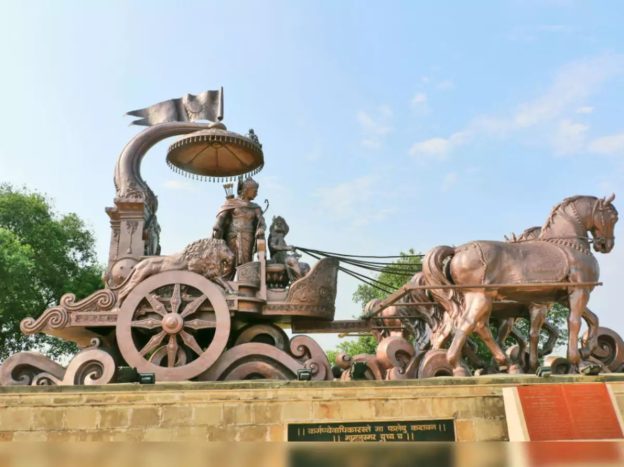
Kurukshetra
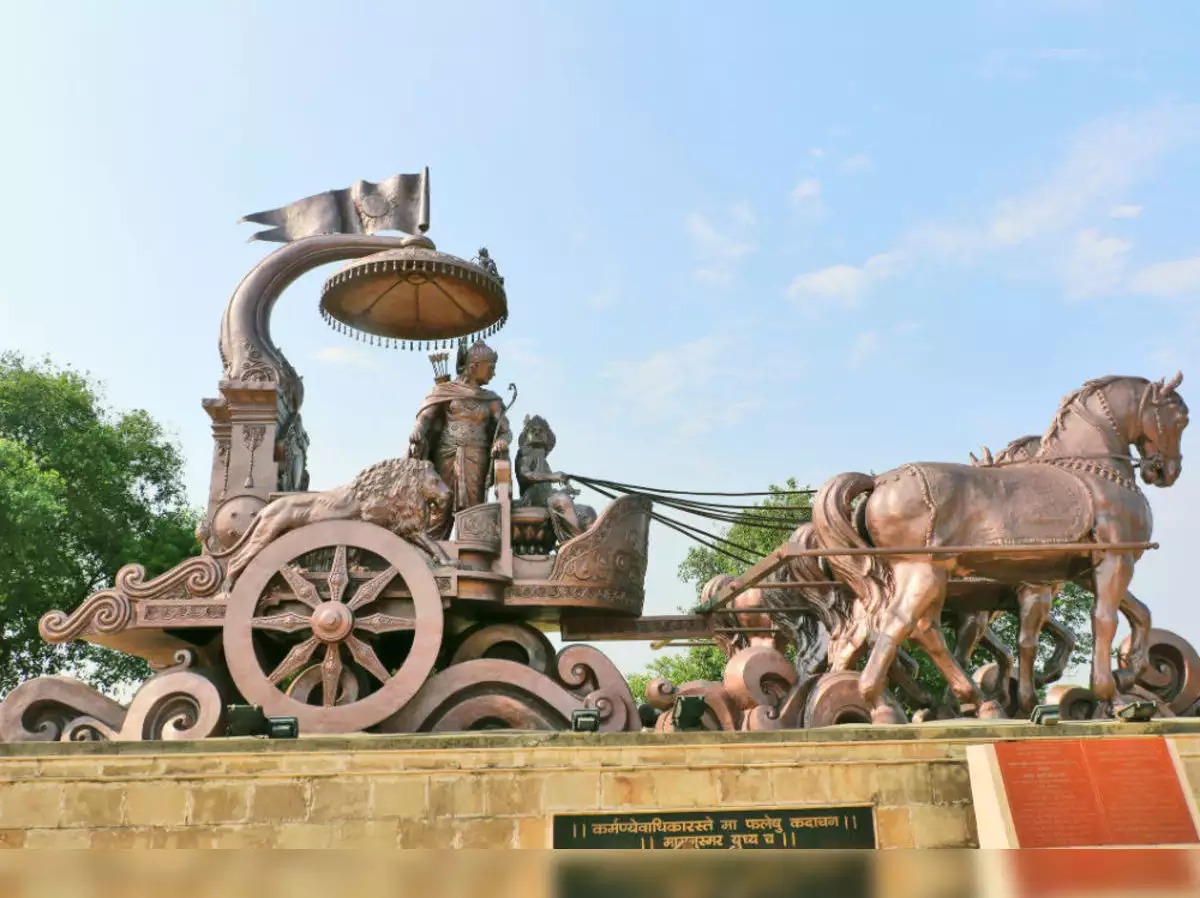
This Holy place Kurukshetra is the place where the great battle of the Mahabharata was fought and it’s the place where Lord Krishna spoke the Bhagavad-Gita.
Kurukshetra lies about one hundred miles north of New Delhi, Kurukshetra, located in the state of Haryana, is a four-hour train or car ride from Delhi. It’s on main highway.
Kurukshetra has also played a dominant role in the history and culture of ancient India for thousands of years before the battle of Mahabharata. Kurukshetra’s religious importance is described in many scriptures, including the Bhagavad-Gita, the Mahabharata, and various Upanishads and Puranas.
The first verse of the Gita refers to Kurukshetra as dharma-kshetra, or “the field of dharma,” indicating that it was already known as a holy place. Kurukshetra is one of those holy places that have borne the imprint of Lord Sri Krishna’s footsteps. Indian government has named the state as ‘Haryana’ which in local language means: ‘Hari ka aana’ (Lord Hari came here).
Kurukshetra was formerly known as Brahmakshetra, Bhrughukshetra, Aryavarta, and Samanta Panchaka. It became known as Kurukshetra because of the work of King Kuru, an ancestor of mighty Pandavas.
The Mahabharata tells of how King Kuru made the land a great center of spiritual culture. King Kuru went there on a golden chariot and used the chariot’s gold to make a plow. He then borrowed Lord Shiva’s bull and Yamaraja’s buffalo and started plowing. When Indra arrived and asked Kuru what he was doing, Kuru replied that he was preparing the land for growing the eight religious virtues: truth, yoga, kindness, purity, charity, forgiveness, austerity, and celibacy. Indra asked him to where he would get the seed of these virtues. King replied that the seed was in his possession. At this Indra laughed and went away.
Undaunted, Kuru performed great penance and continued to plow. After the king had cultivated land for several days, Lord Vishnu appeared before him and asked as to what he was doing? King replied in the same manner as he had done when questioned by Indra. Vishnu asked Kuru to give Him the seed and that He would sow it for him. At this Kuru put forward his right arm and the same was cut into 1000 pieces with the Chakra of Vishnu and sown in the field. King Kuru then offered his left arm, his 2 legs and then his head to Lord Vishnu for sowing. This act of Kuru pleased Vishnu very much and Indra also appeared at this stage and told that he was very much pleased with his sacrifice and told him to ask for any boon from him. Kuru there-upon begged of him 2 boons: one, that this land would forever remain a holy land named after himself, and the other, that anyone dying here would get entry to heaven irrespective of his sins or virtues. Being thus blessed both by Lord Vishnu and Lord Indra however, other demigods expressed doubts. They said that death without sacrifice did not merit a place in heaven. Finally, Kuru and Indra arrived at a compromise: Indra would admit into heaven anyone who died there while fighting or performing penance. So Kurukshetra became both a battlefield and a land of piety. Thus King Kuru with wealth of his state and his austerities established at Kurukshetra an extensive institution of spiritual culture for humanity as a whole.
Sripad Madhavacharya, a great Vaishnava Acharya, who is also the third son of Vayu (after Hanuman and Bhima) visited here around 1250 AD. During his visit he dug-up a certain piece of land in Kurukshetra and found the mace (club/gadaa) used by Bhima on the battle of Kurukshetra. Later after showing this to his disciples he again kept back the gada to the place where Bhima originally kept it after the battle.
The Vamana Purana says that nine sacred rivers and seven sacred forests exist in the region.
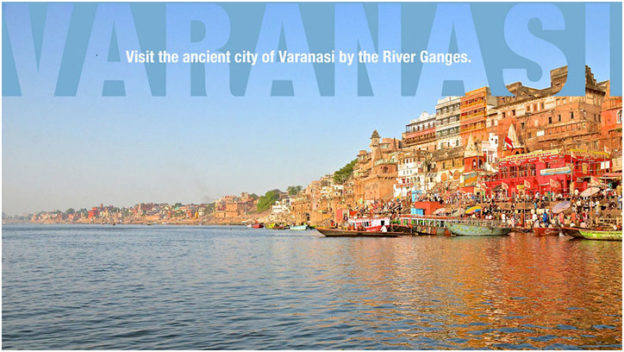
Varanasi
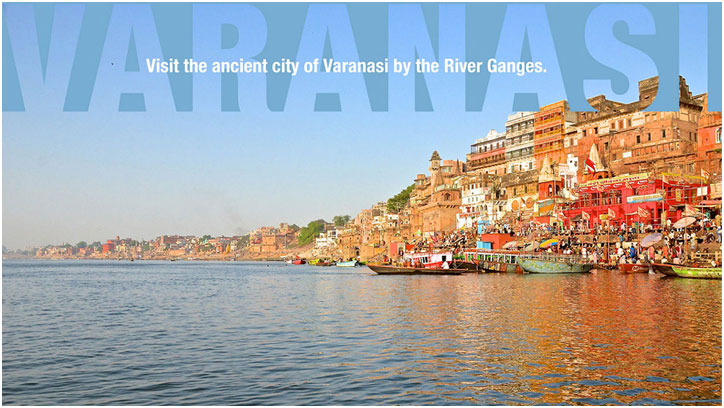
“Varanasi is one of the most ancient cities of learning. This was a place where hundreds of enlightened beings lived at a time. In every street, you had an enlightened being to meet.”
A city as old as time. A city that has seen the world turn, tides change and generations of humans born and die. Varanasi or Kashi, which has been standing the tests of time for over 5,000 years is said to be one of the oldest inhabited cities in the world.
There are supposed to be 2,000 temples in Varanasi. It is 125 km east of Allahabad, on the bank of the Ganges.
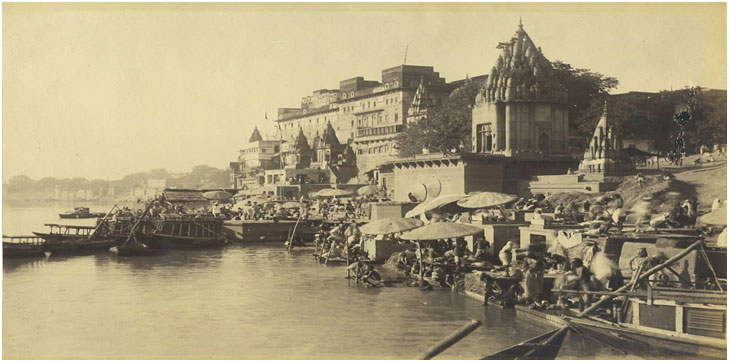
In Mark Twain’s words, “Benares is older than history, older than tradition, older even than legend, and looks twice as old as all of them put together.”
What draws millions of pilgrims from all over the world to the city of Varanasi is the fact that it is one of the holiest of the seven sacred cities in India. It is called the spiritual capital of India, this magnificent city of learning radiates endless energy. Despite being witness to ancient civilizations come and go over centuries, Varanasi is still alive, unabashedly colorful, vibrant, and wonderfully rich in history and legends.
Varanasi or also popularly known as Banaras or Kashi has been given several poetic adjectives such as ‘the city of temples’, ‘the holy city of India’, ‘the religious capital of India’, ‘the city of light’, ‘the city of learning’, ‘the culture capital of India’, etc.
Varanasi, the holy ‘City of Light’ shines bright, both physically and metaphorically. It is believed that a single dip in the holy waters of the Ganges can wash away a lifetime of sins.
According to Puranic history, Varanasi was founded by the Lord Shiva and was his favorite abode. In one verse of the ancient religious text of Skanda Purana, Shiva says, “The three worlds form one city of mine, and Kāśī is my royal palace therein.” The Kashi Khanda of Skanda Purana gives a great detailed description about the glories of this Holy place.
In Varanasi, the most natural and inevitable cycle of life and death is celebrated and revered with as much gusto. Also known as ‘Maha-smashana’ or ‘The Great Cremation Grounds’, the holy city humbles you by bringing you face to face with the balance of life and death.
Many old people come to Varanasi to die and to be burned at the burning ghats along the river. It is believed that anyone who dies in Varanasi attains moksha (liberation). It is said that being burnt at Varanasi adds to the pious credits of someone, therefore many bodies are brought here to be cremated.
A boat ride across the sacred Ganges perfectly captures the spirit of Varanasi. Countless candlelit paper boats with flowers carrying people’s prayers float their way across the waters. Countless pilgrims take a holy dip in the waters, others meditate in solitude and the rest bow their heads in prayer along the Ghats.
As the sun goes down, the evening ritual of worship, called the Ganga Aarti, unfolds.
Varanasi has been the original hub of art, culture, spirituality and music. Many prominent Indian saints, philosophers, poets, writers, and musicians live or have lived in Varanasi. Several major figures of the Bhakti movement were born in Varanasi, including Kabir and Ravidas.
Varanasi is home to the Kashi Vishwanath temple, one of the most important places of worship in the country, considered to be one of the twelve Jyotirlingas of Lord Shiva, holding great significance in the spiritual history of India.
Near Varanasi, there is a 1500 year old Mahabodhi temple marking the spot of the legendary Bodhi tree, under which Buddha meditated and attained enlightenment. Buddha delivered his first sermon at Sarnath, near Varanasi, thereby giving birth to Buddhism.
- Kasi: Where River Varuna & Asi Merges with Ganges
- The Kashi Vishwanath temple
- Sankat Mochan Hanuman Temple
- Durga Temple
- Tulsi Manas Temple
- New Vishwanath temple
- Ghats (River Front)
- Celebrations, Festivals, Melas of Varanasi
- Sarnath
- How to reach Varanasi
- Lord Chaitanya Mahaprabhu visit to Varanasi
- Story of King Divodasa and Return back of Lord Shiva to his own city
- Story of Ganga’s descent on earth and her arrival at Varanasi